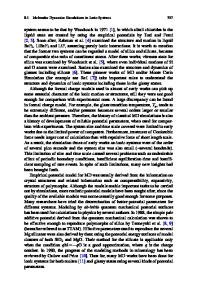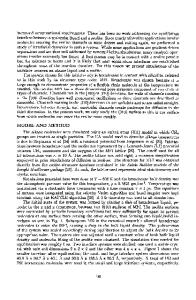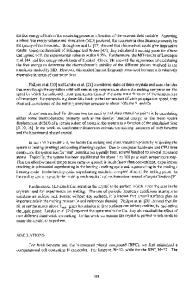Molecular Dynamics Simulations of Polymer-Nanotube Composites
- PDF / 1,340,758 Bytes
- 6 Pages / 415.8 x 637.2 pts Page_size
- 30 Downloads / 399 Views
Shaffer and Windle report one order of magnitude increase in the tensile elastic modulus in polyvinyl alcohol composites of 50 wt% nanotubes.[7] Continued optimization of the mechanical properties of these systems requires detailed knowledge of their structure and energetics, including nanotube-matrix shear strengths and adhesive energies. Reported in this paper are results from a preliminary set of molecular dynamics simulations that model nanocomposites composed of (10,10) nanotubes in an amorphous polyethylene matrix. These simulations represent the case of weak nanotube-matrix adhesion and do not address issues such as nanotube functionalization or mechanical kinking of the nanotubes. For a system with the nanotube traversing an entire periodic supercell (a system of perfectly aligned, infinite-length nanotubes), the enhanced modulus matches predictions given by the rule of mixtures. For a finite nanotube 6 nm long, no load transfer is observed at small strains, and the modulus of the system matches that of the matrix. For large strains the simulations predict regions of polymer matrix surrounding the nanotubes with densities near that of the initial unstrained matrix. MOLECULAR DYNAMICS SIMULATIONS The molecular dynamics simulations were carried out using DL-POLY,[8] a large-scale molecular dynamics simulation package available from Daresbury Laboratory. Two systems were modeled. The first system consisted of a supercell with periodic boundaries containing the 199 Mat. Res. Soc. Symp. Proc. Vol. 593 © 2000 Materials Research Society
polymer with a (10,10) nanotube traversing the entire cell in one direction (Figure la). This configuration models a nanocomposite with perfectly aligned nanotubes of infinite length. The second system consisted of a similar periodic cell containing a capped nanotube -6 nm long (Figure 1b). Both systems were of comparable size with -12,000 atoms and a - 5x5x10 nm cell before strain was applied. -
-
(a)
Figure 1: (a) Infinite length nanotube composite; (b) Finitelength nanotube composite.
(b)
Interatomic forces within the nanotubes were modeled with a many-body empirical bondorder potential.[9] The polyethylene matrix was modeled as 8 (9, if no nanotube present) chains containing 1095-1420 united atom CH 2 monomers. Bond lengths within the matrix were constrained to 1.53 A using the SHAKE algorithm. Angle bending forces were modeled with a harmonic valence angle potential having an equilibrium angle of 112.8130 and barrier of 520 kJ/mol, and a torsional potential of the form
*(c)= AI(1 + cosca) + A 2(1-cos2a)+A 3(l+cos3cc)
(1)
was used where A,=-18.087, A2=-4.88, and A3=31.8 kJ/mol.[10] Non-bonded interactions within the polyethylene matrix and between the matrix and nanotubes were modeled with Lennard-Jones 6-12 potentials using the parameters in Table I. The configurations were initiated by randomly generating the polymer chain coordinates on a diamond lattice surrounding the nanotube using an initial density of
-0.8
g/cm3 .
The matrix was then equilibrated for
appro
Data Loading...











